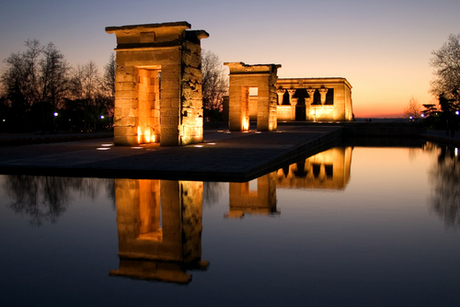The Debod Temple
Many people are surprised to learn that there is an authentic Egyptian temple dating from the 2nd Century BC in the middle of Madrid and dedicated to the gods Amon and Isis.
In the early 2nd century BC, Adikhalamani (Tabriqo), the Kushite king of Meroë, started its construction by building a small single room chapel dedicated to the god Amun. It was built and decorated on a similar design to the later Meroitic chapel on which the Temple of Dakka is based. Later, during the reigns of Ptolemy VI, Ptolemy VIII and Ptolemy XII of the Ptolemaic dynasty, it was extended on all four sides to form a small temple, 12 X 15 m, which was dedicated to Isis of Philae. The Roman emperors Augustus and Tiberius completed its decorations.
From the quay there is a long processional way leads to the stone-built enclosure wall, through three stone pylon gateways and finally to the temple itself. The pronaos, which had four columns with composite capitals collapsed in 1868, and is now lost. Behind it lay the original sanctuary of Amun, the offering table room and a later sanctuary with several side-rooms and stairs to the roof.
Due to the construction of the Aswan Dam in 1960, many valuable monuments and archeological sites were in danger of being destroyed. The UNESCO made an appeal to countries to help save these monuments, and as thanks for the aid given by Spain, particularly in helping to save the sacred buildings of Abu Simbel, the Egyptian government donated this temple to the Spanish people in 1968.
The temple originally stood in Debod in the Nile Valley not too far from the city of Aswan, but the need for the new dam meant that it had to be moved elsewhere or it would have remained underwater forever.
So it was dismantled stone by stone in 1969 and shipped to the Spanish port city of Valencia, from where it was then taken by train to Madrid. That's where it was reconstructed and open to the public in 1972.
Today it stands near Plaza de España, next to the Paseo del Pintor Rosales, with a surrounding park from where it is possible to admire the Guadarrama mountains and the Spanish capital's most outstanding sunset. Further below is an attractive rose garden, the Rosaleda.
On the temple itself you may admire some carved reliefs, and upstairs in the museum there are photographs depicting the monument's history. The temple is laid out in the same way as it was orientated in Egypt, from east to west.
The reassembled gateways appear to have been placed in a different order than when originally erected. Compared to a photo of the original site, the gateway topped by a serpent flanked sun appears not to have been the closest gateway to the temple proper. It constitutes one of the few works of ancient Egyptian architecture which can be seen outside Egypt and the only one of its kind in Spain.
This site is also historical, as it was the location of the former Montaña barracks, which were stormed by the populace during the Civil War in 1936. You can get there via flight to Madrid.



